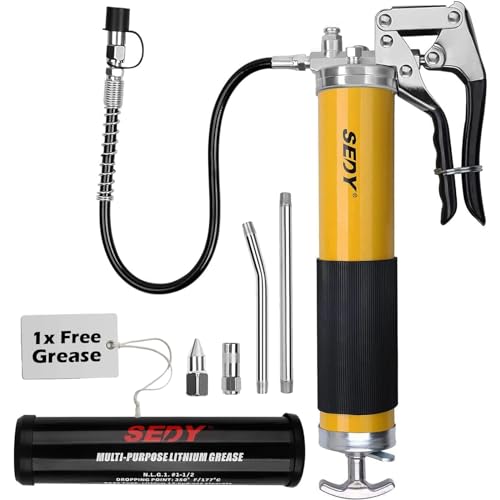Keeping your equipment properly lubricated can mean extending the lifespan of machinery by several years or having them crumble before the warranty expires. In the right hands, a grease gun can be an irreplaceable tool for maintaining optimal levels of lubrication on machine components. In this guide, we’ll show you our picks of the best grease guns available today, as well as explain in detail what you need to look for when shopping for one.
This website is supported by readers. As an Amazon Associate we earn from qualifying purchases.
Buying Guide: How to Find the Best Grease Gun
Grease guns are specialty tools you may or may not be aware of, but if you spend a lot of time fiddling with your car or lawn tools, it can be an indispensable tool to have. In this section, we’ll explain everything you need to know about finding the perfect grease gun for your lubricating needs.
Types of Grease Guns—Manual, Air, Electric
Grease guns typically fall into one of three categories—manual, air, and electric.
Manual grease guns include lever and pistol-grip types that are used for light lubricating applications. The main difference between these two types is levers require the use of two hands whereas pistol-grip grease guns can be operated in a single hand. Manual grease guns dispense grease more slowly so the user has greater control over how much or little lubricant to apply.
Air or pneumatic grease guns are ideal for industrial settings. They attach to an air compressor that delivers great bursts of air volume to apply large quantities of grease for lubricating heavy-duty machinery. This may not be the most efficient tool for everyday use at home, but it offers much room to grow as you see fit.
Electric grease guns, specifically battery-operated, are those that don’t require cords, hoses, or cables to work. Instead, the onboard battery creates enough pressure buildup to dispense grease on demand rather than manually pumping or pressurization via an external tool.
What You’re Lubricating
A good way to determine which type of grease gun you need is by knowing what you plan on using it for. For instance, if you’re greasing heavy machinery used for commercial purposes, a pneumatic grease gun may be the most suitable option. If you need to keep your lawn mower or other garden tools well lubricated, a basic manual or battery-operated grease gun will suffice.
Loading
Loading up a grease gun with lubricant can be done by either using a cartridge or through suction. Cartridges are much a lot more convenience since they are cleaner and easier to use, though they are pricier than suctioning. Conversely, suctioning lubricant into the grease gun is cheaper but a lot messier. If you’re worried about polluting the environment, stick to cartridges.
Accessories
Grease guns can come with a variety of different accessories to make applying grease a lot easier. Such accessories include grease gun meters that helps in determining how much lubricant is being applied to avoid premature breakdown of bearings, needle injectors to shoot grease into tight spots, and grease dust caps that extend the lifespan of the grease gun by protecting it from dirt and debris.
FAQ
1. What are grease guns?
Grease guns are simple tools used to apply lubricant to moving parts. They can be used in commercial settings or otherwise, wherever moving parts are found. Grease guns are split into three categories—manual, air, and electric.
2. How much grease is enough?
In general, one stroke per shaft inch is enough grease, though it depends entirely on the grease gun model. Each model delivers a different amount of grease per stroke—roughly 2 to 3 grams—so you need to measure how much grease is dispensed with each stroke. You can do this manually by putting the tool on a scale.
3. When should I use grease?
Grease should be applied for machinery that is run intermittently or stored for long periods at a time. It stays in place to create a lubricating film to keep any moving parts from rusting over during long storage times. Also, you should use a grease gun to lubricate parts of a machine that aren’t easily accessible. The right coupler attachment should help introduce grease into tight spaces without much effort.
4. What is drop point of grease?
The drop point is an indication of the grease’s resistance to heat. It’s the temperature range where the grease loses its semi-solid state and becomes a liquid that drips out, requiring more grease to keep the machine properly lubricated. Each type of oil and grease has a different drop point.
Conclusion
After reading this guide, you should have a rough idea of what it takes to find a good grease gun. The tool should not only be easy to use but also be the right type for whatever machinery you need to lubricate. It’s important that you know what you’re using it for before settling on a particular grease gun model.


